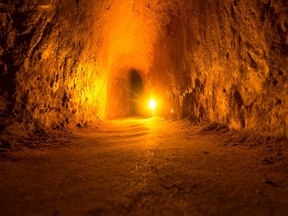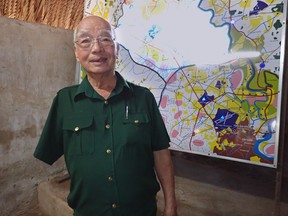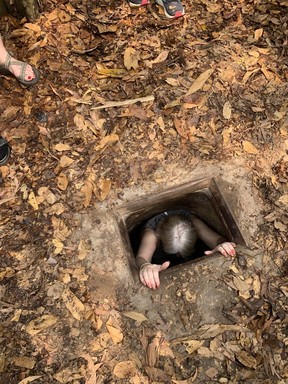Hidden tunnels and historic landmarks shine a light on Vietnam's painful past
As the country marks 50 years of reunification, memories of war coexist with hope for the future

Reviews and recommendations are unbiased and products are independently selected. Postmedia may earn an affiliate commission from purchases made through links on this page.
Article content
Huynh Van Chia, 80, stands proudly at attention — an empty sleeve where his right arm should be — as he recalls his terrible years as a Viet Cong guerrilla in the tunnels of Cu Chi, some 65 km outside of Ho Chi Minh City in Vietnam.
“For people like me who lived in the tunnels, we came out from the tunnels when the war ended, but we have problems with hearing, but also seeing… It was not easy for myself,” he said through a translator from Trafalgar Tours. “When the war ended, it took time for me to recover and for me to feel better.”

It’s impossible to imagine life underground for so long, especially after crouching — or crawling, as taller people have to do — through a scant 20 to 80 metres of them. Small sections of the Cu Chi tunnels are open for tourists to explore if they have the nerve. They are pitch-black, steamy hot, silent except for the laboured breathing, and disorienting.
Cu Chi is an immense network of interconnected tunnels and larger rooms, 268 kilometres all told, connecting former Viet Cong support bases on the outskirts of Saigon (as Ho Chi Minh City is still commonly called) all the way to the Cambodian border. The network included field hospitals, kitchens, meeting and living areas and armament bunkers. The original section was built in 1948 as Vietnam fought for independence against the French. Newer tunnels were constructed for the “American War,” as it’s called in Vietnam.
Cu Chi is an immense network of interconnected tunnels and larger rooms, 268 kilometres all told, connecting former Viet Cong support bases on the outskirts of Saigon (as Ho Chi Minh City is still commonly called) all the way to the Cambodian border. The network included field hospitals, kitchens, meeting and living areas and armament bunkers. The original section was built in 1948 as Vietnam fought for independence against the French. Newer tunnels were constructed for the “American War,” as it’s called in Vietnam.
“We had to eat whatever was available. We had rice, cassava – sweet potato. We tried to grow food along the Saigon River. But, of course, we had to hide away from our enemy. Also, local people in the yellow areas, when they went out, they sometimes left food in areas for us. We’d go at night to collect it,” recalled Van Chia.

At its peak, 3,500 guerrillas stayed in the tunnels. The entire system had room for 41,000 people, but they never had to stay in the tunnel at the same time. “We only used it when it was not safe to be above,” said Van Chia, who still lives in the area and was asked to come speak to our tour group.
It was a powerful talk, and the kind of experience many in the group said is why they are repeat Trafalgar guests. It was the 10th trip for one Australian couple and the 14th for a Calgary woman, Alison Gilbart, who said, “I look for excursions that I wouldn’t have the opportunity to do on my own.”
When American troops moved into the Ben Dinh area, they unknowingly built a base on top of some of the tunnels. Van Chia said the Viet Cong would strike at night and disappear into the tunnels, leaving the U.S. troops to fight what seemed like ghosts.
No comments:
Post a Comment